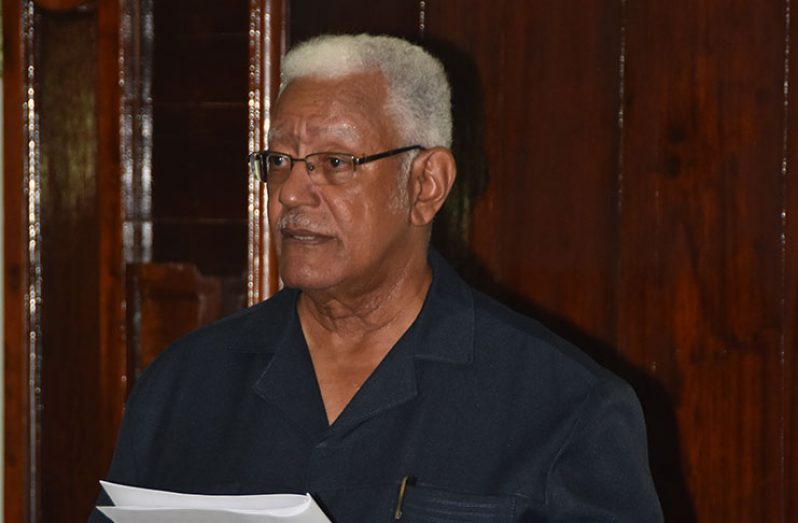MINISTER of Agriculture, Noel Holder has affirmed that the intermediate savannahs, located in the Upper Demerara and Upper Berbice districts of Region 10, are now being considered as the new agricultural frontier for Guyana.
Holder and a delegation from the Ministry of Agriculture made this announcement at an outreach held in the Regional Democratic Council’s 10 boardroom on Thursday.
He said that the move to commence large-scale agricultural production in these areas are as a result of government’s effort to pursue mitigation and adaptation measures to fight climate change, therefore there is need to move agricultural activities inland and to higher ground.
Another area earmarked for massive agricultural extensions are the South Rupununi Savannahs of Region Nine.
Holder said that massive agricultural stations will be established at Ebini, in Region 10, and will include orchards, nurseries and seed production as well as cattle rearing establishments to provide breeding stock to farmers.
“These initiatives will create new employment opportunities, both directly and indirectly, as the country’s economic base is moved inland and will complement other activities such as mining, forestry and support service activities,” Minister Holder said.
He posited that with Region 10’s strategic location, and its wealth of borders spanning all three of the country’s main rivers, the project is bound to be a success.
“This region is unique; there is no other region like this, so well connected, well wired to the entire country,” he said.
More importantly, the region has no threat of rising sea levels, has skilled labour, and vast land areas of over 17000 square kilometres. With the decline in mining activities, he opined that the region’s survival is dependent on agricultural production, and to ensure this strategy reaps success, good planning and governance are necessary for both social and economic development.
Several studies have already been done in an effort to garner success, among them land allocation planning, land air and river transport planning, water supply and distribution planning, institutional and organisational framework, a social services plan, a physical infrastructural plan, agricultural services plan, and a study of the areas eco-tourism potential.
IDB FINANCING
Minister Holder, however, expressed his disappointment that despite the region’s budgetary allocation has skyrocketed over the past two years, there was no allocation for agriculture. But the good news is that the proposed Sustainable Development Agricultural Programme will be financed by the Inter-American Development Bank at a cost $105.7M for the period of 2017 to 2022. Some of the crops that will be cultivated under the project are soya beans, corn and orchard crops, in addition to cattle rearing.
Dr. Jean David, who is the focal point of the Region 10 sustainable agriculture project, outlined in her presentation that the savannahs that will be exploited sum up to 270, 000 square kilometres, and include areas such as Kimbia, Ebini, Ituni/Tacama, Kibilibiri, Eberoabo and Wiruni.
These savannahs, she said, have a history of cattle rearing, legumes and orchard production with the brown soil that has been deemed fertile.
They are, however, in dire need of infrastructural and support services such as land regularisation, health and transport services. In fact, it was outlined that the satellite small-scale farmers in the areas struggle to source markets for their produce because of limited transportation and accessibility.
As a result of the foregoing limitations, many of the farm produce are left to go to waste. In the process of land allocation, Dr. David outlined that there is need for transparency, and that each farmer should submit just cause as to why a plot of land should be allotted to them.
Studies have indicated that 55 farming plots have been identified: 22 at Ebini/Kimbia, five at Wiruni, 13 at Ituni/Tacama, and 18 at Kibilibiri/Eberoabo. These savannah lands include a mixture of scrub, forest, swamp, savannahs and waterways.
Dr. David also pointed out that this large- scale project will not dislocate small farmers or affect them in any way; that in fact the Ministry of Agriculture will work in synergy with these farmers and provide whatever assistance they may need.
Minister Holder said he well understands the plight of the small-scale farmers, and that there need for a different approach when it comes to agriculture and marketing. Farmers, he said, need to ascertain their market and how their produce will be transported before they plant crops and it is wasted.
He said, too, that more information needs to be garnered as to the level of agricultural activities there is in the region, since he does not even know how many farmers there are, so as to provide the needed support to them.
He however said that he is collaborating with the Minister of Public Infrastructure for a boat to return to the Berbice River.




.png)









